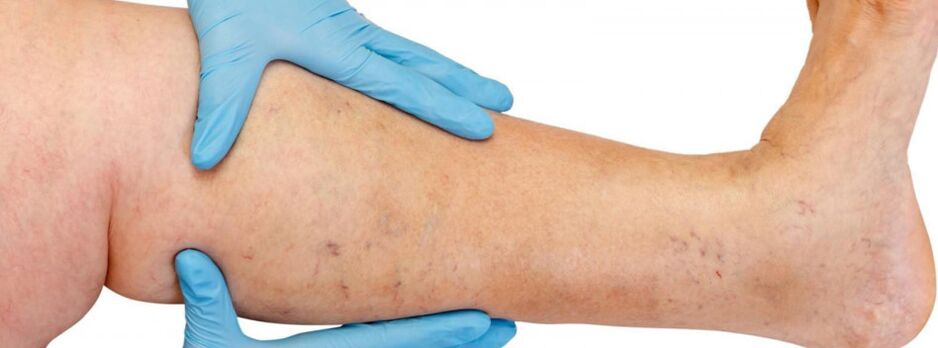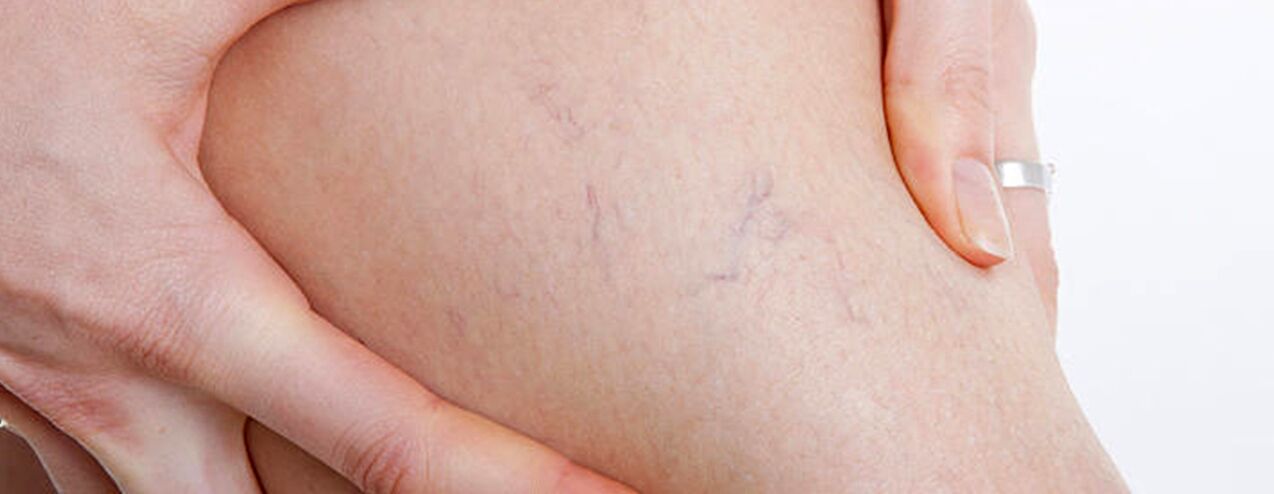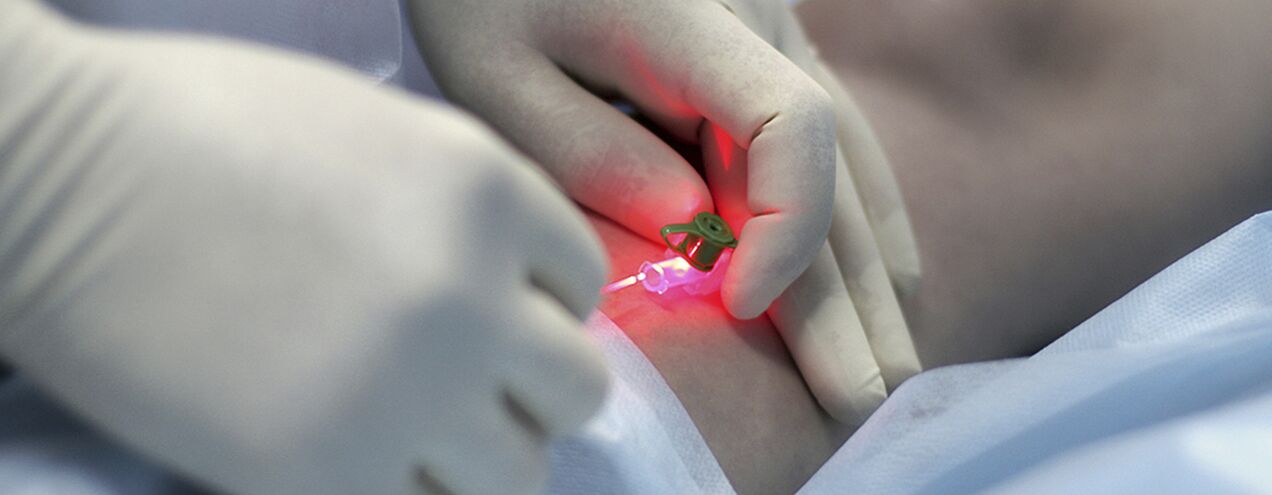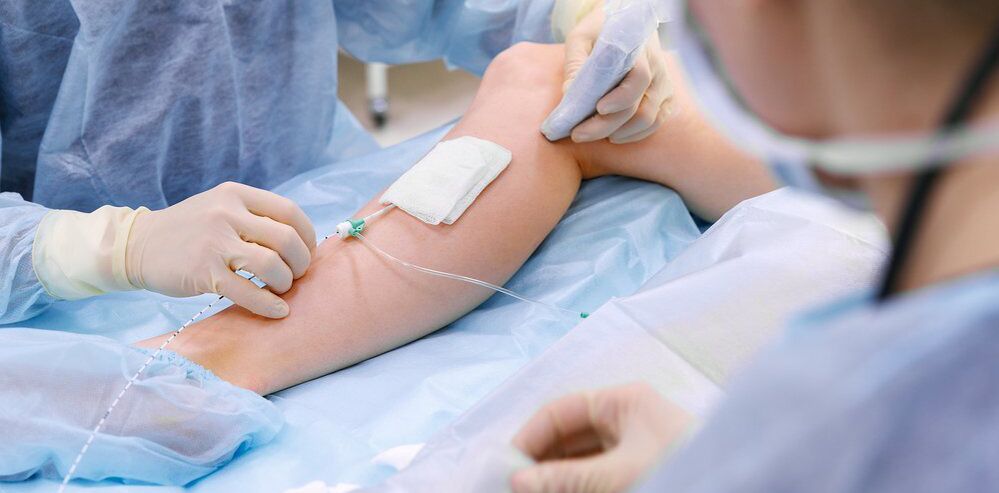
The anatomical structure of the venous system of the lower extremities is very variable. Knowledge of the individual peculiarities of the structure of the venous system, assessing the data of instrumental examination, plays an important role in choosing the right method of treatment.
The veins of the lower extremities are divided into superficial and deep veins. The superficial venous system of the lower extremities starts at the venous plexus of the toes, which form the venous network of the dorsum of the foot and the dorsal arch of the foot. The medial and lateral peripheral veins arise from it and merge into the great saphenous vein and the small saphenous vein, respectively. The great saphenous vein is the longest vein in the body, contains 5-10 pairs of valves, usually its diameter is 3-5 mm. It originates in the lower third of the lower leg in front of the medial epicondyle and originates in the subcutaneous tissue of the lower leg and thigh. In the groin, the V. saphena magna flows into the V. femoralis. Sometimes a large trunk vein on the thigh and lower leg can be represented by two or even three trunks. The V. saphena parva begins in the lower third of the lower leg on its lateral surface. In 25% of cases, it drains into the popliteal vein in the popliteal fossa. In other cases, the small saphenous vein may arise above the popliteal fossa and drain into the femoral vein, great saphenous vein, or deep leg vein.
The deep veins of the dorsum of the foot begin with the dorsal metatarsal veins of the foot and drain into the dorsal venous arch of the foot, from where blood flows into the anterior tibial veins. At the level of the upper third of the lower leg, the anterior and posterior tibial veins unite to form the popliteal vein, which lies laterally and slightly behind the artery of the same name. In the area of the hollow of the knee, the V. saphena parva, the veins of the knee joint, empties into the V. poplitea. The deep femoral vein usually drains into the femur 6-8 cm below the inguinal crease. Above the inguinal ligament, this vessel receives the epigastric vein, the deep vein surrounding the ilium, and merges into the external iliac vein, which flows into the internal iliac vein at the sacroiliac joint. The paired common iliac vein begins after the confluence of the external and internal iliac veins. The right and left common iliac veins merge to form the inferior vena cava. It is a large unvalved vessel, 19-20 cm long and 0. 2-0. 4 cm in diameter. The inferior vena cava has parietal and visceral branches through which blood flows from the lower extremities, lower torso, abdominal organs, and small pelvis.
Perforating (communicating) veins connect deep veins with superficial ones. Most of them have valves that are located suprafascially and through which blood flows from the superficial veins to the deep ones. There are direct and indirect perforating veins. Direct lines connect the deep and superficial venous network directly, indirect lines indirectly, that is, they first flow into the muscle vein, which then flows into the deep.
The vast majority of perforating veins originate from tributaries and not from the trunk of the great saphenous vein. The perforating veins of the medial surface of the lower third of the leg are insufficient in 90% of patients. On the lower leg, the most common failure of Cockett's perforating veins, which connect the posterior branch of the large saphenous vein (Leonardo vein) with deep veins. In the middle and lower third of the thigh there are usually 2-4 of the most permanent perforating veins (Dodd, Gunther), which connect the trunk of the great saphenous vein directly to the femoral vein. In varicose vein transformation of the small truncal vein, incompetent communicating veins are most commonly observed in the middle and lower third of the lower leg and in the area of the lateral malleolus.
Clinical course of the disease

Basically, the expansion of varicose veins occurs in the system of the large truncal vein, less often in the system of the small truncal vein and begins with the tributaries of the trunk of the vein on the lower leg. The natural course of the disease at the initial stage is quite favorable, the first 10 years or more, in addition to a cosmetic defect, nothing can bother patients. If timely treatment is not carried out in the future, complaints of heaviness, fatigue in the legs and their swelling after physical exertion (long walks, standing) or in the afternoon, especially in the hot season, appear. Most patients complain of leg pain, but a detailed survey shows that it is precisely the feeling of fullness, heaviness and fullness in the legs. Even with a short break and an elevated position of the limb, the severity of the sensations decreases. It is these symptoms that characterize venous insufficiency at this stage of the disease. If we talk about pain, other causes must be excluded (arterial insufficiency of the lower extremities, acute venous thrombosis, joint pain, etc. ). The subsequent progression of the disease, in addition to an increase in the number and size of dilated veins, leads to the occurrence of trophic disorders, more often due to the addition of incompetence of perforating veins and the occurrence of valvular insufficiency of deep veins.
With insufficiency of the perforating veins, trophic disorders are limited to all surfaces of the lower leg (lateral, medial, posterior). Trophic disorders in the initial stages are expressed by local hyperpigmentation of the skin, then thickening (hardening) of subcutaneous fat is added to the development of cellulite. This process ends with the formation of an ulcerative-necrotic defect, which can reach a diameter of 10 cm and more, reaching deep into the fascia. A typical site of occurrence of venous trophic ulcers is the region of the inner ankle, whereby the localization of ulcers on the lower leg can be different and diverse. At the stage of trophic disorders, there is severe itching and burning in the affected area; some patients develop microbial eczema. Pain in the area of \u200b\u200bthe ulcer cannot be expressed, although in some cases it is intense. At this stage of the disease, heaviness and swelling in the leg become permanent.
Diagnosis of varicose veins
It is especially difficult to diagnose the preclinical stage of varicose veins, since such a patient may not have varicose veins in the legs.
In such patients, the diagnosis of varicose veins of the legs is mistakenly rejected, although there are symptoms of varicose veins, evidence that the patient has relatives who developed this disease (hereditary predisposition), ultrasound data on the first pathological changes in the venous system.
All this can lead to missed appointments for the optimal start of treatment, the formation of irreversible changes in the vein wall and the development of very serious and dangerous complications of varicose veins. Only if the disease is detected at an early preclinical stage, it is possible to prevent pathological changes in the venous system of the legs with a minimal therapeutic effect on varicose veins.
Avoiding various diagnostic errors and establishing the correct diagnosis is possible only after a thorough examination of the patient by an experienced specialist, the correct interpretation of all his complaints, a detailed analysis of the history of the disease and the most modern devices about the state of the venous system of the legs (instrumentaldiagnostic methods).
Duplex scanning is sometimes performed to pinpoint the exact location of perforating veins, with color-coded veno-venous reflux. In case of insufficiency of the valves, their leaflets no longer close completely during the Valsava test or the compression tests. Valve insufficiency leads to the occurrence of venovenous reflux, high through the incompetent saphenofemoral fistula and low through the incompetent perforating veins of the leg. With this method it is possible to register the backflow of blood through the protruding leaflets of an incompetent valve. That is why our diagnostics has a multi-stage or multi-stage character. In a normal situation, the diagnosis is made after ultrasound diagnostics and examination by a phlebologist. In particularly difficult cases, however, the test must be carried out in stages.
- First, a thorough examination and questioning is carried out by a phlebologist.
- if necessary, the patient is referred for additional instrumental research methods (duplex angioscanning, phleboscintigraphy, lymphoscintigraphy);
- Patients with concomitant diseases (osteochondrosis, varicose eczema, lymphovenous insufficiency) are invited to consult leading expert consultants on these diseases) or additional research methods;
- All patients who require surgery are consulted in advance by the surgeon and, if necessary, by the anesthesiologist.
treatment
Conservative treatment is indicated mainly for patients who have contraindications for surgical treatment: depending on the general condition, with a slight dilation of the veins, causing only cosmetic inconvenience, in case of refusal of surgical intervention. Conservative treatment is aimed at preventing further development of the disease. In these cases, patients should be advised to bandage the affected surface with an elastic bandage or wear elastic stockings, periodically bring the legs into a horizontal position and perform special exercises for the foot and lower leg (flexion and extension in the jumping andknee joints). to activate the muscle-vein pump. The elastic compression accelerates and improves blood flow in the deep veinsof the thigh, reduces the amount of blood in the trunk veins, prevents the formation of edema, improves microcirculation and contributes to the normalization of metabolic processes in tissues. The dressing should start in the morning before getting up. The bandage is applied with a slight pull from the toes to the thigh with mandatory coverage of the heel and ankle. Each subsequent round of bandage should overlap the previous one by half. It is recommended to use certified therapeutic knitwear with an individual choice of the degree of compression (from 1 to 4). Patients should wear comfortable, hard-soled shoes with low heels, avoid prolonged standing, heavy physical labor, and work in hot and humid areas. If, due to the nature of production activity, the patient has to sit for a long time, then the legs should be raised and a special stand of the required height should be substituted under the feet. It is advisable to walk a little every 1-1. 5 hours or stand on tiptoe 10-15 times. The resulting contractions of the calf muscles improve blood circulation and venous drainage. During sleep, legs must be betrayed in an elevated position.
Patients are recommended to limit water and salt intake, normalize body weight, regularly take diuretics, drugs that improve venous tone / Depending on the indication, drugs that improve microcirculation in tissues are prescribed. For treatment, we recommend the use of non-steroidal anti-inflammatory drugs.
Physical therapy plays an important role in preventing varicose veins. In uncomplicated forms, water procedures are useful, in particular, swimming, warm (not higher than 35 °) foot baths with a 5-10% solution of table salt.
compression sclerotherapy

The indications for injection therapy (sclerotherapy) for varicose veins are still being discussed. The method consists in the introduction of a sclerosant into the dilated vein, its further compression, sclerotherapy and sclerosis. Modern drugs used for these purposes are quite safe, i. H. do not cause necrosis of the skin or subcutaneous tissue when administered extravascularly. Some specialists use sclerotherapy for almost all forms of varicose veins, while others completely reject the method. Most likely, the truth lies somewhere in between, and it makes sense that young women in the initial stages of the disease would use an injection method of treatment. The only thing is that they need to be warned about the possibility of recurrence (higher than with surgery), the need to constantly wear a fixing compression bandage for a long period of time (up to 3-6 weeks), and the likelihood of multiple sessions.
Patients with telangiectasia ("spider veins") and reticular dilatation of small truncal veins should be included in the group of patients with varicose veins, since the causes of these diseases are identical. In this case, together with sclerotherapy, it is possible to perform thempercutaneous laser coagulation, but only after excluding lesions of the deep and perforating veins.
Percutaneous Laser Coagulation (PCL)
This is a method based on the principle of selective photocoagulation (photothermolysis), which is based on the differential absorption of laser energy by different body substances. A feature of the procedure is the non-contact nature of this technology. The focusing attachment concentrates the energy in the blood vessels of the skin. Hemoglobin in a vessel selectively absorbs laser beams of a specific wavelength. Under the action of a laser in the lumen of the vessel, the endothelium is destroyed, which leads to the gluing of the vessel walls.
The efficiency of PLC directly depends on the depth of penetration of the laser radiation: the deeper the vessel, the longer the wavelength should be, therefore PLC has rather limited indications. For vessels with a diameter of more than 1. 0-1. 5 mm, microsclerotherapy is most effective. Given the extensive and branched spread of spider veins on the legs and the variable diameter of the vessels, a combined method of treatment is currently being actively used: at the first stage, sclerotherapy of veins with a diameter of more than 0. 5 mm is performed, then a laser is usedto remove the remaining "asterisks" of smaller diameter.
The procedure is virtually painless and safe due to the light (skin cooling and anesthetics are not used).devicerefers to the visible part of the spectrum, and the wavelength of the light is calculated in such a way that the water in the tissue does not boil and the patient does not get burns. Patients with high sensitivity to pain are recommended to apply a cream with a local anesthetic effect beforehand. Erythema and edema subside after 1-2 days. After the course, some patients may experience darkening or lightening of the treated area of \u200b\u200bthe skin for about two weeks, which then disappears. In people with fair skin, the changes are hardly noticeable, but in patients with dark skin or a deep tan, the risk of such temporary pigmentation is quite high.
The number of interventions depends on the complexity of the case - the blood vessels are of different depths, the lesions can be insignificant or occupy a fairly large skin surface - but usually no more than four sessions of laser therapy (5-10 minutes each) are needed. The maximum result in such a short time is achieved due to the unique "square" shape of the light pulse of the device, which increases its efficiency compared to other devices and at the same time reduces the possibility of side effects after the procedure?
surgery
Surgical intervention is the only radical treatment for patients with lower extremity varicose veins. The purpose of the operation is to eliminate pathogenetic mechanisms (veno-venous reflux). This is achieved by removing the main trunks of the great and small saphenous veins and ligating the insufficient connecting veins.
Surgical treatment of varicose veins has a hundred-year history. In the past, and still today, many surgeons used large incisions along the course of varicose veins, general or spinal anesthesia. Traces after such a "miniphlebectomy" remain a lifelong memory of the operation. The first vein operations (after Schade, after Madelung) were so traumatic that the damage from them exceeded the damage from varicose veins.
In 1908, an American surgeon developed a method of plucking the saphenous vein using an olive-tipped carbide probe and vein plucking. In an improved form, this surgical method for removing varicose veins is still used in many public hospitals. Varicose veins are removed through separate incisions as suggested by surgeon Narat. Therefore, the classic phlebectomy is called the Babcock-Narata method. Phlebcock-Narath phlebectomy has disadvantages - large postoperative scars and impaired skin sensitivity. Working capacity is reduced by 2-4 weeks, which makes it difficult for patients to agree to surgical treatment of varicose veins.
Phlebologists of our network of clinics have developed a unique technology for treating varicose veins in one day. Difficult cases are dealt withcombined technique. The main large varicose veins are removed by inversion stripping, which requires minimal intervention through mini incisions (from 2 to 7 mm) of the skin that leave practically no scars. The use of minimally invasive techniques involves minimal tissue trauma. The result of our operation is the elimination of varicose veins with an excellent aesthetic result. We perform combined surgical treatment under complete intravenous or spinal anesthesia, and the maximum hospital stay is up to 1 day.

Surgical treatment includes:
- Crossectomy - crossing the confluence of the trunk of the V. saphena magna into the deep vein system
- Stripping - removal of a fragment of varicose veins. Only the remodeled varicose vein is removed and not the entire vein (as in the classic variant).
actuallyminiphlebectomycame to replace the method of removing varicose veins of the main veins according to Narata. Previously, skin incisions of 1-2 to 5-6 cm were made in the course of the varicose veins, through which the veins were identified and removed. The desire to improve the cosmetic result of the procedure and to be able to remove veins not through traditional incisions, but through mini-incisions (punctures), forced doctors to develop tools that allow them to do almost the same thing through a minimal skin defect. Thus, sets of phlebectomy "hooks" of various sizes and configurations, as well as special spatulas, appeared. And instead of the usual scalpel for piercing the skin, they began to use scalpels with a very narrow blade or needles of a sufficiently large diameter (for example, a needle for taking venous blood for analysis with a diameter of 18 G). Ideally, the trace of a puncture with such a needle is practically invisible after a while.
We treat some forms of varicose veins on an outpatient basis under local anesthesia. Minimal trauma during miniphlebectomy, as well as low risk of intervention, allow this operation to be performed in a day clinic. After a minimal observation in the clinic after the operation, the patient can go home independently. In the postoperative period, an active lifestyle is maintained, active walking is encouraged. The temporary incapacity to work is usually no more than 7 days, after which it is possible to start work.
When is a microphlebectomy used?
- With a diameter of varicose veins of a large or small trunk vein of more than 10 mm
- After a thrombophlebitis of the main subcutaneous trunks
- After trunk recanalization after other forms of treatment (EVLK, sclerotherapy)
- Removal of very large individual varicose veins.
It can be an independent operation or part of the combined treatment of varicose veins, combined with laser vein treatment and sclerotherapy. Tactics of application are determined individually, always taking into account the results of duplex ultrasound examination of the patient's venous system. Microphlebectomy is used to remove veins in various locations that have been altered for various reasons, including on the face. Professor Varadi from Frankfurt developed his handy tools and formulated the basic postulates of modern microphlebectomy. The Varadi phlebectomy method gives an excellent cosmetic result without pain and without hospitalization. This is a very careful, almost decorative work.
After vein surgery
The postoperative period after the usual "classic" phlebectomy is quite painful. Sometimes large hematomas bother, edema occurs. Wound healing depends on the surgical technique of the phlebologist, sometimes there is lymph leakage and prolonged formation of noticeable scars, often after a large phlebectomy there is a violation of sensitivity in the heel area.
On the other hand, wounds after miniphlebectomy do not need to be sutured, since they are only punctures, there are no pain sensations and no damage to the skin nerves was observed in our practice. However, such results of phlebectomy are obtained only by very experienced phlebologists.
Make an appointment with a phlebologist
Be sure to consult a qualified specialist in the field of vascular diseases.



















